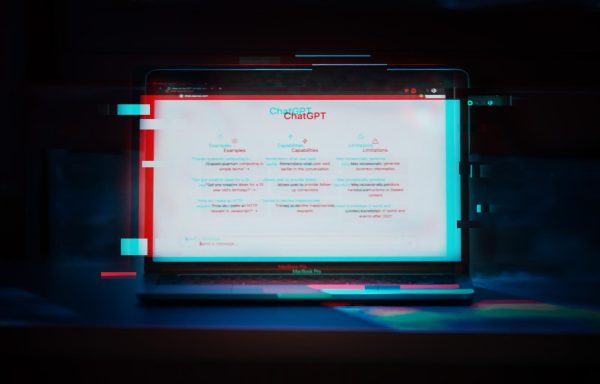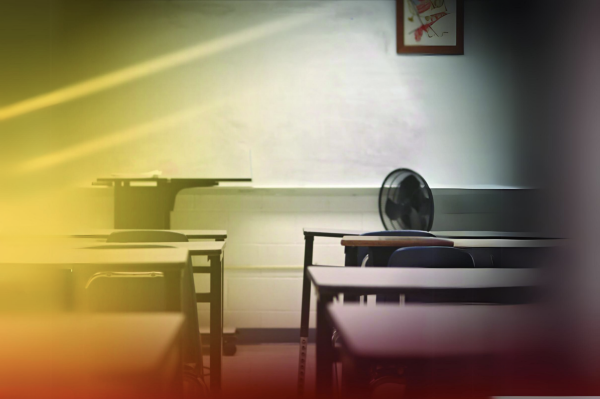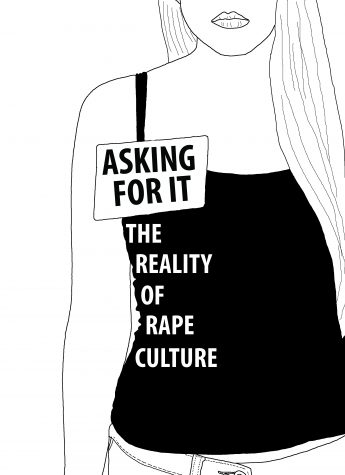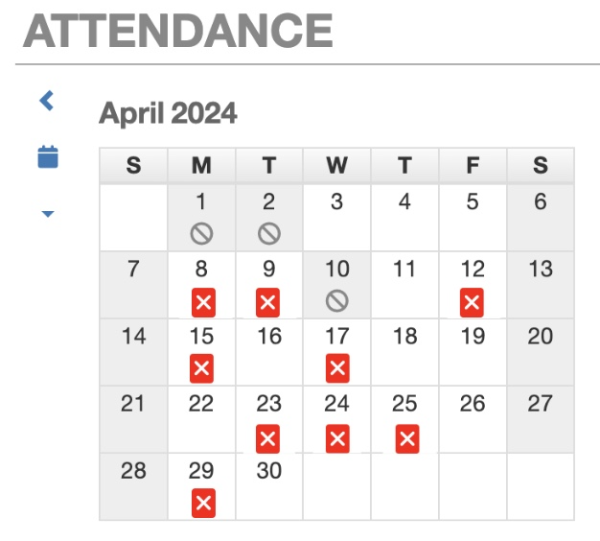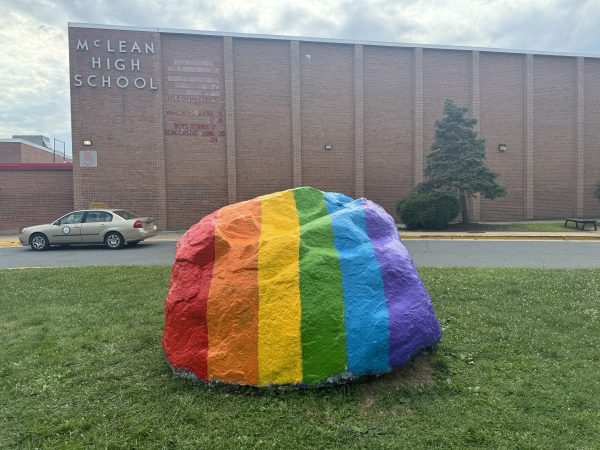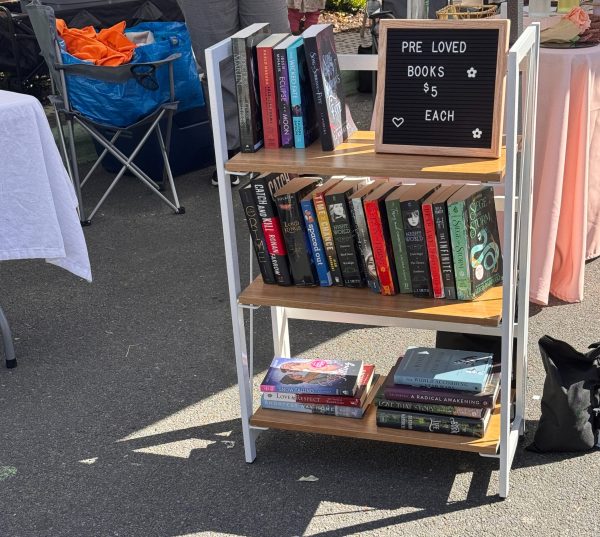A Divided Highlander
McLean students polarized more than ever amid 2020 election
November 3, 2020
Following months of a deadly, uncontrolled pandemic and cries for justice and equity from marginalized groups in the U.S., Fairfax County was set to begin the new virtual school year. Excited for the start of their senior year, a friend group from Marshall High School posted a first day of school photo waving a campaign flag in support of President Donald Trump.
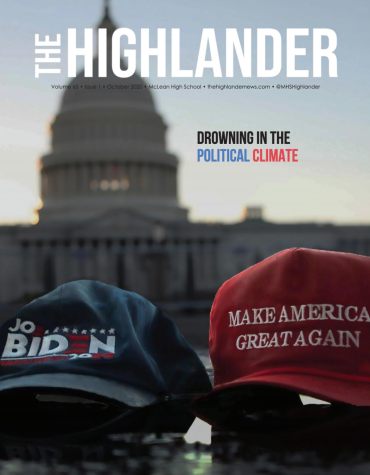
Despite the hostility towards conservatives and Trump supporters over the summer, Marshall seniors Finn Gillespie, Luke Plawin, Gavin Kelbaugh and Caleb Cook posted the now-infamous picture on Instagram, where it spread quickly, sparking county-wide controversy.
“When the photo was taken we did not even think about it being sent around on socialmedia. And we definitely had no idea it would receive the amount of backlash that it did or that people would even be offended,” Gillespie said. “This was all really a spur of the moment decision when a friend pulled up and happened to have the flag.”
Most notably, the photo was re-posted on a popular Virginia-based hip-hop news account, @vahiphopandnews. The post gained about 1,600 likes and was flooded with aggressive comments targeting the boys. Some of the comments even came from their classmates.
“After the post blew up on the [hip-hop news] page, I read comments from friends I used to be close with calling us Trumpers, MAGA boys or straight up saying things like, ‘We don’t claim them,’” Gillespie said. “That’s noteven mentioning the death threats some of my other friends in the picture have received, including one of my friends whose address was leaked in the comments.”
As former friends and other Fairfax County students attempted to publicly shame the group, they were determined to not cave to the harassment. Their families and friends showed support for them, regardless of their own party alignment.
“My friends and family both supported me during it and understand the right of having your own opinion. They also support me in standing up for what I believe in,” Kelbaugh said.
Much like their Democratic counterparts, the Marshall seniors wanted to express their conservative political ideologies.
“On social media, at Marshall High School, there’s some students that were posing with these big Trump signs on a truck, and that got a lot of students angry,” school board member emeritus Ryan McElveen said. “At the end of the day, you know, there are free speech protections, and those students had every right to be doing that.” McElveen graduated from Marshall in 2004.
Aware of the liberal majority throughout Northern Virginia, the Marshall seniors point to a lack of political understanding as the reason for the divide within the community.
“The political divide at Marshall and all around FCPS is extremely left leaning and I believe way too one-sided. This can cause young people who aren’t that politically educated to automatically assume all Republicans are racist and terrible people,” Gillespie said. “To me, this is just sad that we are living in a world where being a Republican is considered repulsive to a large portion of the population.”
The attacks from fellow classmates and students fueled the Marshall students’ frustration with the divide. They said they do not care that a majority of FCPS students are liberal, but they want the school system to create a more politically tolerant county.
“Northern Virginia is one of the most Democratic areas in the nation, so I understand why people are so extreme in their views. However, I believe FCPS does not do anything to promote healthy political conversation, nor do they emphasize the importance of different opinions in politics,” Plawin said. “If all Americans agreed on everything, we wouldn’t have politics—it would just be a relentless echo chamber. That being said, kids need to learn that it is OK to disagree as long as you are respectful in doing so.”
The discontent these students feel is not solely found on social media, but also in the classroom.
“I’ve been told my opinion isn’t valid because of my race and skin color in a class discussion, and the teacher told the student, ‘Oh sweet pea, you can’t say that,’” Plawin said. “If roles were reversed and I told a minority their opinion was invalid because of their race and sex, which I never have nor would I do, I would be sent to the principal’s office. As long as teachers live by these double standards, and the administration allows them, nothing will change.”
As the country nears the 2020 U.S. Presidential Election, the split is worsening. While many accuse the incumbent administration for dividing the country, the Marshall seniors say that both sides of the aisle are to blame.
“I personally think Trump does not help lessen the polarization in the United States, and may even create more,but he is not to blame for it,” Plawin said. “America has been trending towards this polarized climate for years now starting under Obama, and it is not any one president’s fault.”
Despite whoever wins the election, the boys unanimously agreed that the divide within the county and the nation as a whole needs to improve.
“I do hope Republicans and Democrats can fix this divide in Northern Virginia after the election regardless of who wins,” Gillespie said. “I do believe given where we are right now, no matter who wins, our country as a whole is on track to become a lot more divided.”
It is hard to imagine a time when students in Fairfax County did not engage in political and national affairs. Millions of Americans travel great distances to the capital to witness a historic presidential inauguration or to attend a massive protest, while McLean students nowadays can easily catch the metro to pay their respects to the late Justice Ruth Bader Ginsberg. But this was not the case 20 years ago.
DISENGAGED UNITY
AP Government teacher Karen McNamara graduated from James Madison High School in 2001. She recalls students being disengaged in political affairs. In a push to get the students active during the election season, McNamara and her classmates were forced to volunteer for a campaign despite the lack of interest. Their disinterest came at an abnormal time for American democracy: the 2000 U.S. Presidential Election.
It was a heated race between Texas Governor George W. Bush and former Vice President Al Gore. On Election Night, major swing state Florida was too close to call and would remain so for a period of time following the election.
After a series of legal battles and district recounts over the hanging chad controversy—a punch-in ballot that was designated as incomplete—Bush managed to clutch Florida’s 29 electoral points in an extremely narrow margin of 200 votes. Bush won the presidency in December.
“With the 2000 election, we came back to class after election week and we did not know the results, and this didn’t concern anyone too terribly much,” McNamara said. “I remember feeling confident that it would eventually be solved in a fair manner. Hanging chads were a joke, and we were a lot less apprehensive about what an undecided election meant for the future of our country.”
At the time of the 2000 election, Virginia was a solid red state. After being GOP-reliant for nearly four decades, the political division seemed dormant during this 40-year period.
“I think Northern Virginia was trending blue certainly before the rest of the state,” McElveen said. “But I do think that as we’ve seen the state become progressively more blue, that there has been more willingness among students to express their opinions.”
When President Barack Obama won Virginia in both his presidential bids, it was clear to political scientists that the state that once housed the capital of the Confederacy was now a blue state. Since then, Virginia rapidly transitioned from a swing state to solid liberal.
“I think when Democrats win races, particularly when we win the governor’s race, we govern in a way that gives
Virginians comfort. So when we didn’t have [Democratic] officials for a long time, they may have wondered, ‘Well, if we elected a Democratic governor…how would it go?’” Senator Tim Kaine (D-VA) said as he spoke with the inaugural fellows of Global Leaders of Fairfax. “Mark Warner was the first [Democrat from Virginia to be elected to the U.S. Senate] in a long time. People who may have thought they were taking a chance on a Democrat saw that he did a good job, they saw that I did a good job, and so we have been re-elected ever since.”
Teachers and elected officials who once attended Fairfax County schools hold differing beliefs as to how the impact of the party switch in Virginia has polarized the political climate. While McElveen said he believes the liberal progression has created a more politically active environment, McNamara said the ruling party has no major effect on the climate in Northern Virginia.
“Between my time in high school and now, I have always found FCPS to be a place focused more on learning than politics. I have been at McLean for 15 years, and I think we have become a more welcoming and accepting community,” McNamara said. “But there will always be people who do not see eye to eye on issues, whether Virginia is a red or a blue state.”
This divide is now more prevalent than ever as Trump and former Vice President Joe Biden take sides on key issues.
FRACTURED INTO FACTIONS
More than 220,000 deaths. George Floyd. Ruth Bader Ginsberg. The aftermath of these three events have motivated the two major political parties to secure a large voter turnout this upcoming Election Day. While the Black Lives Matter (BLM) movement and the COVID-19 pandemic would have seemingly encouraged the parties to act as a unified front, they have only divided the two even more.
This discontent has further sharpened the split between Trump-supporting Republicans and Democratic Biden advocates. While living near our nation’s capital enables students to become engaged and informed about American politics, it also sparks some of the greatest political division among students and families.
“I don’t interact with Republicans and Trump supporters that much, just because when it comes to social issues, a difference of opinion on human rights is not something that I can accept, and it’s not something that I’m willing to accept,” said junior Leah Siegel, a key member in the Sunrise Movement, a student-led activism club. “But I still think it’s extremely divided, and I think that a lot of times it’s difficult to hear each other out, and it’s something I’m working on. I think it’s something that everyone should always try to work on.”
While Siegel is interested in conducting thorough, mature debates with members of the opposition party, students who identify as Republican and hold conservative values do not feel a sense of open-mindness in the McLean community when it comes to discussing politics.
“As we [draw] closer to the election, I feel like [Republicans] have been less and less inclined to share in fear of getting judged. I’m even hesitant to tell people what I believe and voice my opinion on things. I’d rather just stay quiet,” junior conservative Reese Smith said.
Republican students have fallen silent. Each party’s stance was adopted by the candidates and became a major contributing factor to the split between the two parties.
“I think that the campaign platforms from both presidential nominees have made our country more divisive. It has become less about unity and more about topics that attack the other side,” said senior Emma Steel, leader of the Equity Task Force for the Committee on Raising Student Voices.
A key issue for millions of Americans is the federal response to the pandemic. Combined with the Trump administration’s controversial response to COVID-19, the contrast between strict mask-wearers versus people eager to return to normalcy has sharpened the public split. Americans gathered and protested across the country during late March and April in an attempt to end lockdowns and quarantine.
On the other end of the spectrum, people who believed Trump was prioritizing the health of the economy over human lives argued that the reopening of the country was unethical.
Opinions regarding social justice have caused the most division between the presidential campaigns, congressional representatives and the American people. Following the deaths of George Floyd and Breonna Taylor, allies of the BLM movement marched in large numbers to protest systemic injustices.
As riots began following the push for police and systemic reform, Americans opposed to the movement attempted to disregard the integrity of the protests, while BLM supporters blamed the opposition for starting the violence.
“Trump is a denier of systemic racism. He is a denier that anything is wrong in America, which harms the movement because we’re unable to make change if the person who is in the highest office in the United States won’t even recognize that the problem exists,” Siegel said. “[Biden] is not the ideal supporter of the Black Lives movement; however, I believe he’s trying to adapt his ways to better fit the BIPOC communities in America. He wants to help everyone and create a more equal society.”
On the other side of the argument, conservative Americans say the Trump administration has supported the Black community far more than the Democrats. After conquering his criminal justice reform legislation, Trump supporters do not believe that the president is actively working to harm the marginalized group.
“I think that Donald Trump has made a conscious effort to remain neutral on issues concerning race while simultaneously not alienating predominantly white communities that helped him get elected,” said junior Marc Lampkin, a Black conservative. “I support the [Black Lives Matter] movement but less so the actual organization itself. I believe they abuse the movement’s purpose to excuse illicit behavior and unethical policies.”
Lampkin said he is rarely called racist by other Black Americans. He said he mostly faces discrimination and name-calling from white, liberal Americans. Despite his personal beliefs about Trump’s moral compass, he thinks Trump is a better candidate than Biden.
“I think that Joe Biden has had a lifetime in politics to prove his value to the country and has fallen short of making any significant difference,” Lampkin said. “While Donald Trump has not been exceptional by any metric, I think he’s been hindered in part by the serious division within the country.”
With the passing of Justice Ruth Bader Ginsberg, the vacancy in the Supreme Court has fueled the tensions between the two parties. Her death is untimely for the Democrats, who do not have the White House or a majority in the Senate—the two powerhouses needed to appoint and confirm the next Supreme Court justice.
A week following her death, Trump nominated judge Amy Coney Barrett to the bench. Not only was the devout conservative Catholic received poorly by liberal Americans, they were unsettled by the idea that the Republican Party would hold a 6-3 majority on the Supreme Court.
“Within weeks of the election, Trump appointed a new justice despite the fact Americans are heading to the polls in November to determine the future of Trump’s presidency,” Steel said. “If he were to lose, it is not fair to the American people that his parting gift is a justice that does not reflect the true values and ideologies of the citizens.”
The same issue arose in the final months of Obama’s second term in office. In the middle of the 2016 U.S. Presidential Election, Justice Antonin Scalia passed away, leaving a vacancy on the bench. Obama attempted to fill the seat with judge Merrick Garland. U.S. Senate Majority Leader Mitch McConnell (R-KY) said the winner of the 2016 election should appoint the next justice as previous administrations had done. He ordered GOP senators to boycott the confirmation hearings, never holding a proper vote for Garland.
“Mitch McConnell and his Republican Senate were following the precedent in 2016 by blocking the president’s appointment,” Steel said. “While Democrats failed to acknowledge that at the time, they have every right to block Amy Coney Barrett now. McConnell continued the precedent in 2016 and should continue it now.”
Steel said Republicans’ clear hypocrisy and defiance of the precedent is furthering the divide amongst the voters. Conservative students beg to differ.
“As long as the Republicans hold the White House and the Senate, Amy Coney Barrett should and will be confirmed to the Supreme Court as cited in the Constitution,” said senior Jacob Fernicola, president of McLean’s Investors Club.
These three issues will play a major role in the outcome of the presidential election. As tensions between the political parties remain high, the voters will choose who they believe is best fit for the country’s highest office.
While students remain separated from one another due to the COVID-19 pandemic, most of their debates are taking place on social media.
DIGITAL DIVISION
As social media increasingly integrates itself into our daily lives, it sharpens the political division between the American people. Social media has allowed for political participation never seen before.
“There’s just really just such a new sense of political activism among students today,” McElveen said. “I’m connected with students on social media. I see the kind of stuff that they put out there. It’s far more sophisticated than anything that we would have done back in the day.”
Before the technology boom of the early 2000s, students resorted to other means of expressing their political opinions. Students wore merchandise promoting their preferred political candidate, designed campaign posters and wrote op-eds for their local newspapers.
“Technology has certainly made it easier for students to convey their political opinions with each other, but only if they choose to share it,” McNamara said. “What you post on Instagram, Twitter, TikTok, if you aren’t comfortable with the world knowing this, you have the choice not to share it.”
Student activists at McLean have taken advantage of their First Amendment rights by sharing their thoughts on issues like protecting reproductive rights or demanding justice for Breonna Taylor.
“I would call myself an activist,” junior Zora Rodgers said. “Because of all of the things that have been going on, I just realized that I needed to wake up and stand up for the people who don’t have a voice. I use my platform [to raise awareness]. I’ve been given the resources to do so.”
Holding leaders and their enablers accountable has been a key mission for activists. When Trump demanded Ilhan Omar, an American congresswoman of Arab descent, move back to her home country, infographics were published on stories
declaring that “if you vote for Trump, you are a racist.” While some would say publicly shaming all Trump supporters is extreme, others believe it is necessary and effective. In fact, they would prefer it if people who disagree unfollow them.
“I don’t find anything I post to be aggressive because I believe that what I share online should be common knowledge,” senior Jasmyne Zu said. “The unjust treatment of minority groups and women are topics that I am constantly bringing attention to to remind people that those issues are still very much prevalent in our society. My end goal of sharing these posts is to bring awareness to significant issues in our country and unite our generation to fight against them.”
When colleges began releasing their return to school plans, most colleges opted to host virtual classes to contain the coronavirus on campus. Immigration and Customs Enforcement declared that all international students must return to their home country if their university was not hosting in-person instruction. After a photo of an immigrant pleading for help made its way across the internet, the demand for reversal of this policy grew to the millions, ultimately managing to convince the Trump administration to overturn this decision.
“Posting things such as Change.org links, petitions and GoFundMe pages is a great way to utilize your platform to get signatures, raise money and most importantly raise awareness for a great cause,” Rodgers said. “Although it may seem useless, it actually makes a big difference. That one signature and that one extra dollar actually goes into something so much bigger than you think, showing that a simple post on your story can do so much for a cause.”
But the use of social media comes with an increase in cyberbullying. Upon posting content conveying their political opinions, students often receive rude remarks that they would never hear in person.
“During my sophomore year, I posted on my story in celebration that states were finally adopting the Heartbeat Bill,” a senior girl who asked to remain anonymous said. “A number of people slid up telling me that my pro-life stance is disgusting and horrifying. One McLean student even went as far to say they wish I was aborted.”
From Democrats bombarding their stories with liberal-leaning infographics to Republicans losing followers for reposting conservative-based content, social media has surely increased the split between the parties. In Northern Virginia, conservative-based media has decreased in fear of facing the wraths of cancel culture.
“Every time I post something on Instagram, I’ve always gotten backlash, whether it just be voicing my conservative opinions or posting anything about Trump,” Smith said. “I always get backlash and people trying to come at me for my beliefs, which half the time they don’t even really completely understand.”
This is not the same for liberal students. Democrats feel more at liberty to post left-wing content without fear of backlash or public remarks.
“I couldn’t care less about what people think of me when I post something political, because everything that I post is something that I think is important and want to bring more awareness to,” Zu said. “I am always open to a debate with anyone who has a different opinion than me, and I don’t care if they unfollow me or not.”
Democrats are willing to openly talk to Trump-supporting Republicans. They say that mature debates and open discussions fix the divide on social media.
“I try to use my Instagram story not for bashing people and their views, but more for informing people of things,” said junior Atticus Gore, former president of the Young Democrats club. “I like giving information on my story about certain events or people, because I think the biggest issue people have is that they don’t have all of the facts or all of the information, and that’s what leads to toxicity.”
BALANCE IN POWER
After Nov. 3, America will learn who their next president will be. On Jan. 20, 2021, whether it is Trump or Biden, the president-elect will recite the oath of office that puts him in charge of the free world. While the peaceful transfer of power has been a lawful tradition in the republic for nearly two and a half centuries, the U.S. still exhibits the division amongst the American people.
While Democrats and Republicans agree that they must work to fix the divide, they have been clear that there is no sign of unity in the near future. Despite their differences of opinion on national and international affairs, there is a sense of agreement that both must compromise for the country to prosper.
“I think learning how to respectfully discuss issues, to try and empathize with people who disagree with you is important,” McNamara said. “McLean has students of all different political viewpoints, but regardless of how many liberal or conservative students there are in my class, I think it is important for students to think about why they side with the issues or policies that they do.”


